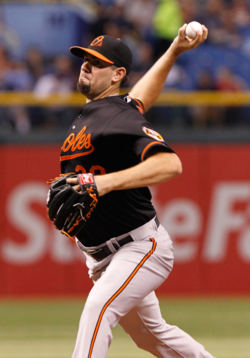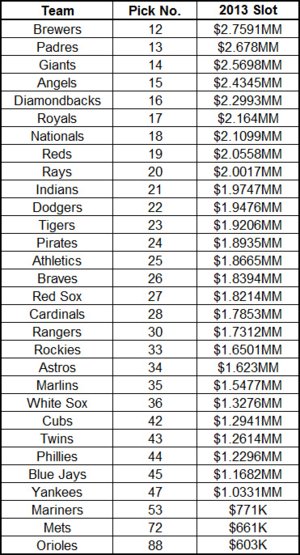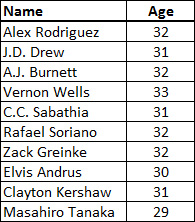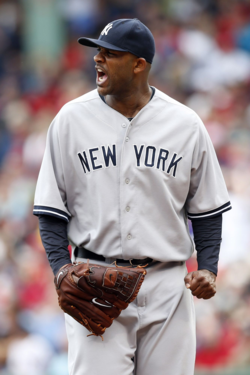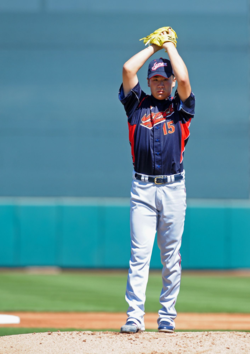The following 40-man roster players have less than five years service time and are out of minor league options. That means they must clear waivers before being sent to the minors, so the team would be at risk of losing them in attempting to do so. I've included players on multiyear deals. This list was compiled through MLBTR's sources. Next, we'll take a look at the AL Central.
Indians: Carlos Carrasco, Josh Outman
Both Carrasco and Outman will be on the Indians' pitching staff, noted Tony Lastoria of FOX Sports Ohio on Monday. Carrasco is battling a few others for the fifth starter job, but if he doesn't earn it he'll go to the pen.
Royals: Brett Hayes, Jarrod Dyson, Justin Maxwell, Pedro Ciriaco, Francisley Bueno, Carlos Peguero, Danny Valencia
Hayes seems to be the favorite to back up Salvador Perez at catcher, as 24-year-old Francisco Pena can get more seasoning at Triple-A. Veteran Ramon Hernandez, signed to a minor league deal, is also in the mix for the Royals' backup catcher job.
Dyson is expected to make the team as the center field backup for Lorenzo Cain, wrote Andy McCullough of the Kansas City Star last week. That leaves Maxwell and Peguero battling for the fifth outfield spot. Maxwell would seem to have a leg up, having played well upon joining the team in a trade last July. His right-handed bat might be of more use to the Royals, who avoided arbitration with Maxwell in a January agreement about a week before acquiring Peguero.
The Royals seem to have room for five infielders, and Blair Kerkhoff of the Kansas City Star wrote last week that Valencia is likely to make the team. That would leave the team without a reserve middle infielder behind Omar Infante and Alcides Escobar. If the Royals do surprise and find a way to include a reserve middle infielder, it would be a competition of Ciriaco, Christian Colon, and Johnny Giavotella.
Bueno is competing with Donnie Joseph and Everett Teaford to become the Royals' second bullpen lefty behind Tim Collins.
Tigers: Don Kelly, Evan Reed, Jose Iglesias
Kelly is in good standing as a super-utility man. There appears to be one bullpen job up for grabs, with pitchers such as Luke Putkonen, Justin Miller, Blaine Hardy, and Casey Crosby (if healthy) among those battling with Reed. The Tigers claimed Reed off waivers from the Marlins about a year ago, and will probably need to put him in their bullpen to start the season to retain him.
Twins: Trevor Plouffe, Anthony Swarzak, Scott Diamond, Sam Deduno, Vance Worley, Eduardo Escobar, Alex Presley, Chris Parmelee
Plouffe and Swarzak are locks to make the club. Plouffe figures to man third base on an everyday basis now that Miguel Sano is out for the season, and Swarzak was among the league's best swingmen in 2013.
Diamond, Deduno and Worley are in the mix for the fifth spot in the rotation, and each can make their case based on historical context. Diamond was the club's best starter in 2012, Deduno has outperformed him since, and Worley was a key component of the Ben Revere trade just one offseason ago before a disastrous 2013 dropped his stock. The trio also has deal with top prospect Kyle Gibson, who is fully recovered from Tommy John surgery. Any of the three could end up in the bullpen, but at least one seems likely to go.
Presley has the inside track to make the club either as the Opening Day center fielder — should Aaron Hicks struggle in Spring Training — or as a fourth outfielder.
Escobar's versatility is appealing to the Twins, and his case for the Opening Day roster has been strengthened now that starter Pedro Florimon had his appendix removed two weeks ago. Florimon is fielding grounders pain-free as of yesterday, per MLB.com's Rhett Bollinger, but his Opening Day status is up in the air. Former Twin Jason Bartlett is in camp as a non-roster invitee and could serve as competition.
Parmelee is a former first-rounder that hasn't hit since a 2011 September call-up. The now-26-year-old demolished Triple-A pitching in 2012 but has batted just .228/.302/.364 over his past 543 PAs in the Majors. He didn't fare much better at Triple-A in 2013. With Oswaldo Arcia and Josh Willingham at the outfield corners, Joe Mauer at first base and Jason Kubel likely to make the club as a DH/corner outfielder, Parmelee's best hope is to lock down a bench role. His experience at first base could give him an edge for that spot.
White Sox: Conor Gillaspie, Ronald Belisario, Mitchell Boggs, Maikel Cleto, Donnie Veal, Alejandro De Aza, Dayan Viciedo
The Sox seem to only have one spot open for a third baseman at this time, though that could change if they trade an outfielder like Dayan Viciedo or Alejandro De Aza. As it stands, Gillaspie is competing for third base with Jeff Keppinger and rookie Matt Davidson. It would be sensible to start Davidson at Triple-A, and it's possible lingering effects of Keppinger's September shoulder surgery could cause him to start the year on the DL.
Boggs and Belisario seem locks for the bullpen after signing as free agents, though Belisario has yet to arrive in camp due to visa issues. A few of the team's relievers are dealing with nagging injuries, but if everyone is healthy and Belisario is in camp as Opening Day approaches, there would seem to be one spot for either Veal (a lefty) or Cleto. Veal is the favorite over Cleto, who joined the team in a waiver claim just last week.
Steve Adams contributed to this post.

